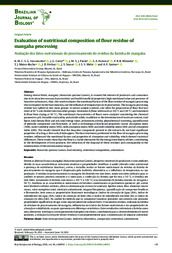Evaluation of nutritional composition of flour residue of mangaba processing.
Evaluation of nutritional composition of flour residue of mangaba processing.
Author(s): VASCONCELOS, K. M. C. S. G.; COSTA, J. G. da; PAVÃO, J. M. S. J.; FONSECA, S. A.; MIRANDA, P. R. B.; ROCHA, T. J. M.; FREITAS, J. D.; SOUSA, J. S.; MELO, I. S. V.; SANTOS, A. F.
Summary: Among several fruits, mangaba (Hancornia speciosa Gomes), it aroused the interest of producers and consumers due to its attractive sensory characteristics and health beneficial properties (high nutritional value and presence of bioactive substances), thus, this work evaluates the nutritional factors of the flour residue of mangaba processing that is despised by the food industry, and the influence of temperature on its production. The mangaba processing residue was splited in two main groups: in natura sample (control), and other for preparation of flour that was dried at 50 °C and divided into two other groups: treatment A (flour with roasts at 110 °C and 130 °C) and treatment B (flour from drying at 50 °C). The nutritional characteristics of flours were analyzed considering the chemical parameters: pH, titratable total acidity and soluble solids, in addition to the determination of moisture content, total lipids, total dietary fiber and ash, total energy value, antioxidant activity, phytochemical screening, quantification of phenolic compounds and flavonoids, as well as technological functional properties (water absorption index (WAI), water solubility index (WSI), milk absorption index (MAI) and milk solubility index (MSI) and oil absorption index (OAI). The results showed that the bioactive compounds present in the extracts do not have significant properties of acting as free radical kidnappers. The heat treatment, performed in the flour of mangaba processing residues, influenced the nutritional factors and properties of absorption and solubility, which showed statistical differences. These results show that the flour is a viable alternative for the energy enrichment of diets, contributing to the development of new products, the reduction of the disposal of these residues and consequently to the minimization of the environmental impact.
Publication year: 2023
Types of publication: Journal article
Observation
Some of Embrapa's publications are published as ePub files. To read them, use or download one of the following free software options to your computer or mobile device. Android: Google Play Books; IOS: iBooks; Windows and Linux: Calibre.
Access other publications
Access the Agricultural Research Database (BDPA) to consult Embrapa's full library collection and records.
Visit Embrapa Bookstore to purchase books and other publications sold by Embrapa.

